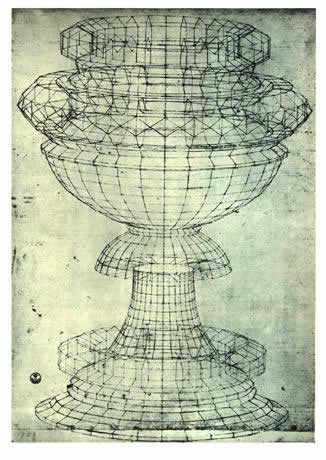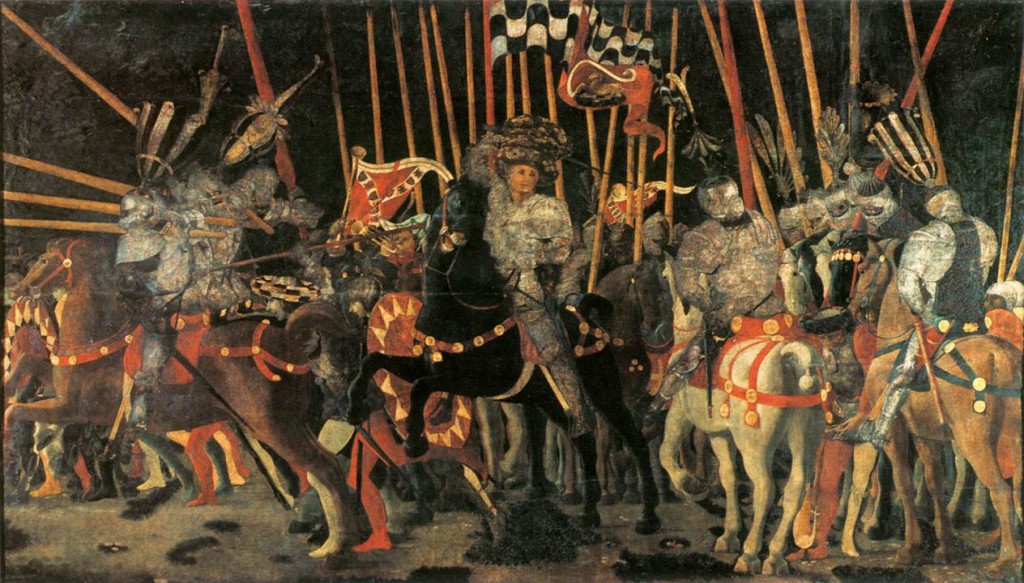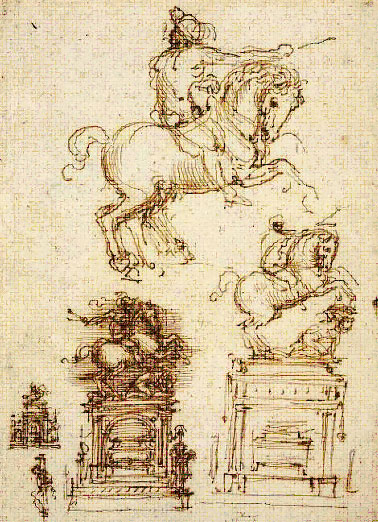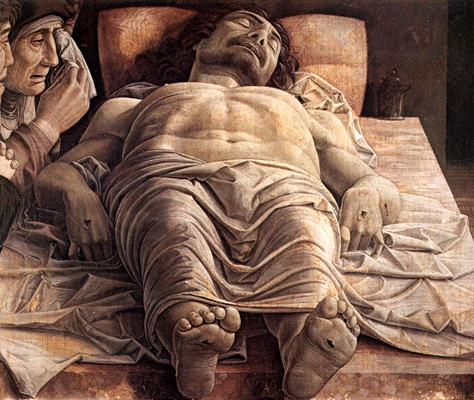“It was said of Uccello that the discovery of perspective had so impressed him that he spent nights and days drawing objects in foreshortening, and setting himself ever new problems. His fellow artists used to tell that he was so engrossed in these studies that he would hardly look up when his wife called him to go to bed, and would exclaim: ‘What a sweet thing perspective is!’ We can see something of this fascination in the painting. Uccello obviously took great pains to represent the various’ pieces of armour which litter the ground in correct foreshortening.
His greatest pride was probably the figure of the fallen warrior lying on the ground, the foreshortened representation of which must have been most difficult. No such figure had been painted before and, though it looks rather too small in relation to the other figures, we can imagine what a stir it must have caused. We find traces all over the picture of the interest which Uccello took in perspective and of the spell it exerted over his mind. Even the broken lances lying on the ground are so arranged that they point towards their common ‘vanishing point’. It is this near mathematical arrangement which is partly responsible for the artificial appearance of the stage on which the battle seems to take place. ( E.H. Gombrich )

The Italian master, Paolo Uccello, epitomizes the rebirth of pictorial space that took place during the Renaissance through the use of perspective illusionism. Uccello and his fellows incorporated the math of perspective vanishing points to render the third dimension into their art works.
To mention perspective is to encounter the core of Paolo Uccello’s( 1397-1475 ) art. He did not however invent this method of depicting a measured, objective three dimensional space on a two dimensional surface; that laurel is likely bestowed on painter, sculptor, and architect Filippo Brunelleschi early in the fifteenth century. This was elaborated by Donatello and given a firm theoretical base by Leon Battista Alberti. He defined a painting as a “transparent window through which we look out onto a section of the visible world.” Thus, a composition should be founded on a triangle, its base at the lower edge of the painting, its apex representing the vanishing point. Nobody, least of all Uccello was immune to such a revolutionary attack on the flat, Gothic picture plane.

"These knights in armour with their long and heavy lances, riding as if to a tournament, may remind us of a medieval romance of chivalry; nor does the way in which the scene is represented strike us at first as very modern. Both horses and men look a little wooden, almost like toys, and the whole gay picture seems very remote from the reality of war. But if we ask ourselves why it is that these horses look somewhat like rocking horses and the whole scene reminds us a little of a puppet show, we shall make a curious discovery. It is precisely because the painter was so fascinated by the new possibilities of his art that he did everything to make his figures stand out in space as if they were carved and not painted."
We are so used to hearing about the Florentine “certezza” , the realist impulse that perspective liberated in fifteenth-century art, that another aspect of this new mode of representation has been clouded over; namely the exquisitely abstract pleasures of its geometric construction. This was Paolo Uccello’s particular obsession, and his devotion to it brought down a good deal of posthumous criticism on his head. Vasari, not one to mince words, said, ” an immoderate devotion to perspective causes an infinite waste of time, fatigues nature, clogs the mind with difficulties, and frequently renders it sterile where it has previously been facile and fertile.”
The tone is that of a Victorian cleric inveighing against self-abuse. “In cases where an artist devotes more attention to perspective than to his figure, ” he continues, ” there arises a dry style full of profiles, generated by the desire of sifting things too thoroughly, in addition to which he frequently becomes solitary, eccentric, melancholy and poor. This,” Vasari concludes, “was the fate of paolo Uccello.”

" The Battle of San Romano is a set of three paintings by the Florentine painter Paolo Uccello (1397–1475) depicting events that took place at the battle of San Romano in 1432. The paintings are in tempera on wooden panels, each over 3 metres long, and were commissioned sometime around 1456 by Cosimo de' Medici, to decorate the newly built Medici Palace. According to the National Gallery, the painting and its two companion panels were commissioned by the Bartolini Salimbeni family in Florence sometime between 1435 and 1460; Lorenzo de' Medici so coveted them that he had them forcibly removed to the Palazzo Medici. They are significant as revealing the development of linear perspective in early Italian Renaissance painting, and are unusual as a major secular commission. The three panels are now divided between three collections, the National Gallery, London (panel shown above), the Galleria degli Uffizi and the Musée du Louvre, Paris."
Such are the misunderstandings that flow from a too rigid categorization of “art” and “science” If perspective is only a realist system , instinct and observation are all that would be needed for any master draftsman to do a drawing like Bellini’s architectural study. But for Uccello, perspective geometry had the same aesthetic dimension as Einstein’s equations or riemannian spatial coordinates possess today for advanced mathematicians. It was a species of Pythagorean ecstasy; the mathematical rule even more beautiful than its uses, the system superior to what could be represented within it.
In this light, Uccello’s studies in perspective may be more comprehensible to us than they were to Vasari. When he incorporated the many forms into “The Rout of San Romano”, such as the checkered hats of the foot soldiers in the Paris panel; it was not for pedantry. Likewise, the intricacy of the chalice study above betokens an immense, and successful, intellectual labor, combined with an insatiable curiosity. Like a chess grandmaster, Uccello lived within his game.

"War is a bright, glorious game in this painting. The pattern of broken lances on the ground suggests a tournament rather than a battle, and even the fallen soldier looks like an empty suit of armour. The beauty of the Tuscan countryside - from the fruit and flowers to the parti-coloured crossbowmen showing up brilliantly against the mellow brown terrain - makes this battle somehow natural and joyful, oddly reminiscent of Botticelli's Primavera, and of course the yellow upright lances of the advancing Florentines are phallic, sexual. Da Tolentino leads his men as if to a dance, dressed in a fantastically ornate costume, while his pageboy rides unarmoured as if this were a chivalrous exercise. Uccello appears to see the clash as a piece of sculpture. And it is his bold enjoyment of its mathematical development of shapes - the lances as long slender cones, the receding grid of broken arms on the ground, the wonderfully three-dimensional horses, the armoured men as sys
of solids extrapolated in space - that makes this such a Renaissance masterpiece."Yet in the “Rout of San Romano” the “lawful construction” is more a property of the objects than of the space, which shows traces of gothic influence that somewhat resemble a medieval tapestry.The only part of the landscape in all three panels to which strict laws of one point perspective aplly is the foreground. On this flat plane, the debris of battle, broken lances and armored bodies, lie in a precisely orthogonal grid, following the lines of perspective toward their vanishing point.
But it was for the treatment of horses and soldiers that Uccello mustered all his powers of naturalism. Each form is conceived in “Rout” as a seprate problem in perspective, and, in the Uffizzi panel, there are a number of different vanishing points, one for each horse. In some places, a form will defy the Albertian rule by displaying two vanishing points, such as the prone corpse to the left of the London panel; here he encountered and did not solve a base inconsistency between correct foreshortening and correct “decorum”. If the body obeyed the rules of one-point perpsective, its feet would be much larger. But you cannot have a pair of big feet sticking out of the picture plane; it looks gross. Mantegna had rthe same difficulty with his “Dead Christ” and tried a similar concealment: the trick being to diminish the feet as well as the head.
Later artist’s did not hesitate to use Uccello’s prototypes, for next to the human figure itself, the horse was the renaissance theme par excellence. Thus, Leonardo drew versions of kicking horses like those in the Uffizi panel. If he was inspired by Uccello, what probably attracted him was the fearsome vitality of their squat legs, lashing out like clubs.And Della Carda’s rearing mount is the direct ancestor of Leonardo’s project for the bronze equestrian monument to Giacomo Trivulzio. But there is also an expressive side to the horses that go beyond looking like ponderous toys that have lost their rockers; it is also a vision of the horse as a demoralizing and inexorable weapon and there it established a threatening tension with “Rout”, adding to the dramatic impact of the work.

da Vinci sketch from 1508, from a monument that was never built owes a great deal to Uccello's equestrians.
Menace transcends the pageantry. “The Rout of San Romano” is a paradox. A picture full of animals and men that presents itself as a paen to the inorganic. It embodies a fascination with masks and artifacts: the glinting, oily steel of breastplate and cuirass,vambrace and pauldron; the cumbersome, waving lances, like the spines of a sea urchin; the yellow moon curve of deadly crossbows; the studs, the roundels, harness bands and trumpets; the iron shod hooves.
The knights cluster and charge, but their faces are invisible. Plumes sprout from their metal heads like monstrous bell-mouthed orchids. Blindering and colliding within the lurid confines of Uccello’s ideal space, the victors and losers of San Romano are united in a dreamlike fatality.
“Van Eyck, in the north, had changed the forms of the International style by adding more and more details from observation and trying to copy the surfaces of things down to the minutest shade. Uccello rather chose the opposite approach. By means of his beloved art of perspective, he tried to construct a convincing stage on which his figures would appear solid and real. Solid they undoubtedly look, but the effect is a little reminiscent of the stereoscopic pictures which one looks at through a pair of lenses. Uccello had not yet learned how to use the effects of light and shade and air to mellow the harsh outlines of a strictly perspective rendering. But if we stand in front of the actual painting in the National Gallery, we do not feel that anything is amiss, for, despite his preoccupation with applied geometry, Uccello was a real artist.” ( Gombrich )
“[Uccello] would remain the long night in his study to work out the vanishing points of his perspective, and when summoned to his bed by his wife replied in the celebrated words: “How fair a thing is this perspective.’” Being endowed be nature with a sophisticated and subtle disposition, he took pleasure in nothing save in investigating difficult and impossible questions of perspective . . . When engaged in these matters, Paolo would remain alone in his house almost like a hermit, with hardly any intercourse, for weeks and months, not allowing himself to be seen . . . By using up his time on these fancies he remained more poor than famous during his lifetime.”
Vasari, Lives of Artists






 COMMENTS
COMMENTS